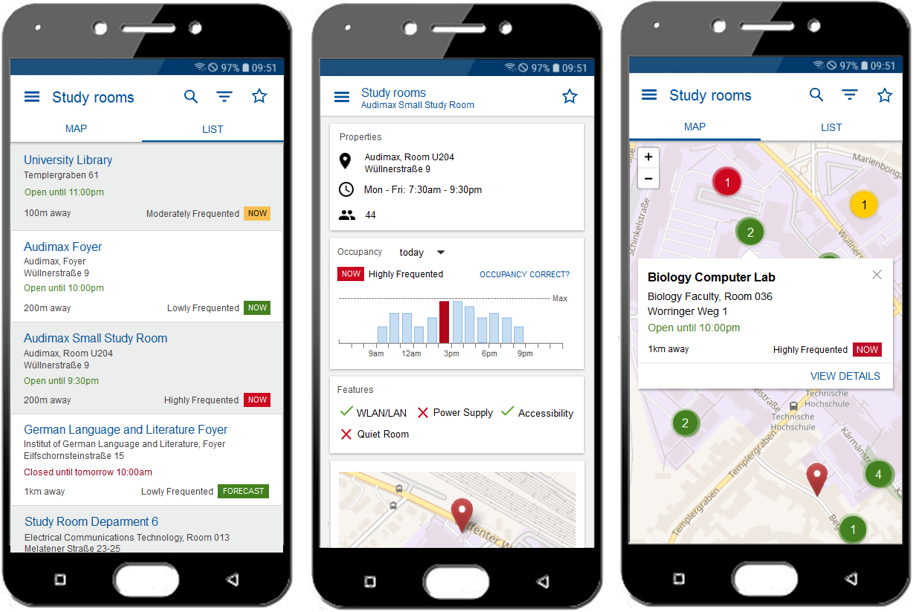—ENGLISH VERSION BELOW—

Quelle: RWTH
Diese Woche möchten wir Ihnen den dritten Teil unserer EUNIS 2019 Serie vorstellen. Das dazugehörige Paper wurde von unseren Kollegen Ramona Renner, Steffen Schaffert und Bernd Decker geschrieben.
Alle Studierenden sind mit dem Problem vertraut, mit dem sie sich beschäftigt haben – der Frage, wie man vor allem in den Klausurenphasen einen Platz zum Lernen findet. Für Studienanfänger kann es besonders schwierig sein, herauszufinden, wo es Lernräume gibt und wann sie geöffnet sind. Diese Suche kann sehr zeitaufwendig und nervenaufreibend sein.
Die Arbeit unserer Kollegin und unserer Kollegen ist ein gutes Beispiel dafür, wie die Bedürfnisse der Studierenden die Entwicklung unserer Services beeinflussen können: In Zusammenarbeit mit dem Vorstand des AStA wurde innerhalb der RWTHApp ein Lernraum-Guide mit integrierter Auslastung entwickelt.
Vor dieser Implementierung existierte eine einfache Liste aller verfügbaren Lernräume auf der RWTH Website. Durch die Aufnahme in die RWTHApp wurde die Sichtbarkeit erhöht. Die Liste ermöglicht nun die Filterung nach Raummerkmalen wie WLAN, Barrierefreiheit, Stromversorgung und Raumtyp. Live-Informationen wie Entfernung, aktuelle Auslastung und Öffnungszeit werden ebenfalls angezeigt. Zusätzlich wurde eine Kartendarstellung integriert, die es den Studierenden ermöglicht, ihren eigenen Standort und die Position der Studienräume sowie die aktuelle Auslastung und Öffnungszeit auf einen Blick zu sehen.
Für jeden Raum zeigt eine Detailseite alle Eigenschaften, Öffnungszeiten, Auslastung und eine Standort-Karte. Diese dient auch als Link zu externen Kartenanwendungen, um das Auffinden der Räume so einfach wie möglich zu gestalten.

Quelle: NTNU
Auf der EUNIS 2019 – CAMPUS FOR THE FUTURE Konferenz gehörte dieses Paper zu den Finalisten für den EUNIS Dørup E-learning Award. Dieser Preis wird für die herausragende und innovative Anwendung von Informationstechnologien im Bildungsbereich vergeben. Berücksichtigte Projekte müssen Innovation, Pädagogik und Technologie als Schlüsselfaktoren für effektives und motiviertes Lernen kombinieren.
Wir freuen uns sehr für unsere Kollegen und sagen Glückwunsch!
Übrigens finden Sie unsere Aktuelles-Meldung zur EUNIS hier. Vorbeischauen lohnt sich.
Verantwortlich für die Inhalte dieses Beitrags ist Sophia Teeuwen.
—ENGLISH VERSION—
This week we would like to present the third part of our EUNIS 2019 series. The corresponding paper was written by our colleagues Ramona Renner, Steffen Schaffert, and Bernd Decker.
All students are familiar with the problem they addressed – how to find places for studying, especially during busy exam periods. For new students it can be particularly challenging to find out where study rooms exist and when they are open. This quest can be very time-consuming and nerve-wrecking.
The work of our colleagues is a great example for how students’ needs can influence the development of our services: In cooperation with the AStA Student Union’s executive committee a study room guide with integrated room occupancy rate indicator was developed within the RWTHApp.
Before the implementation, a simple list of all available study rooms existed on the university’s website. By including it into the RWTHApp its visibility was increased.
The list now allows filtering by room features such as Wi-Fi connectivity, accessibility, power supply and room type. Live information such as distance, current occupancy levels and opening status is also displayed. Additionally, a map view was integrated enabling students to see their own location and the position of study rooms as well as the current occupancy rate and opening status at a glance. For each room a “details page” shows all features, opening hours, occupancy, and a map of its location. This map also serves as a link to external map applications making finding the rooms as easy as possible.
The occupancy rates are estimated by using the number of devices currently connected to a particular access point – fully anonymously. There is a certain level of inaccuracy involved when converting it to the number of people present in a certain room: Some might have more than one device or none at all, others might be logged into the access point but be outside of the room, etc.
A machine learning algorithm uses past occupancy rates – amongst other data – to make predictions about future occupancy, not only taking into account weekdays and times of the day but also lecture vs. lecture-free periods.
In the future, user feedback could be used to improve the machine learning algorithms for more accurate occupancy rate calculations. Furthermore, data from the university-wide room management system could be used for retrieving basic room information making the data more up-to-date as well as reducing maintenance efforts.
At the EUNIS 2019 – CAMPUS FOR THE FUTURE conference this paper was among the finalists for the EUNIS Dørup E-learning Award. This award is given for the outstanding and innovative use of information technologies in education. Projects must combine innovation, pedagogy and technology as key factors for effective and engaging learning.
We are very pleased for our colleagues and say CONGRATULATIONS!
By the way, you can find our latest news about EUNIS here. It is worthwhile to have a look.
Responsible for the content of this article is Sophia Teeuwen.




